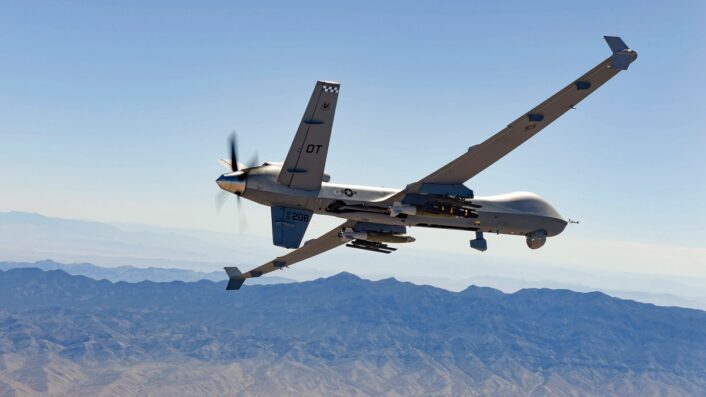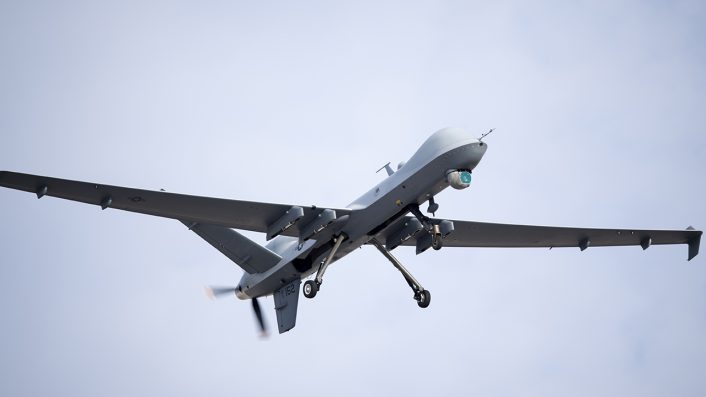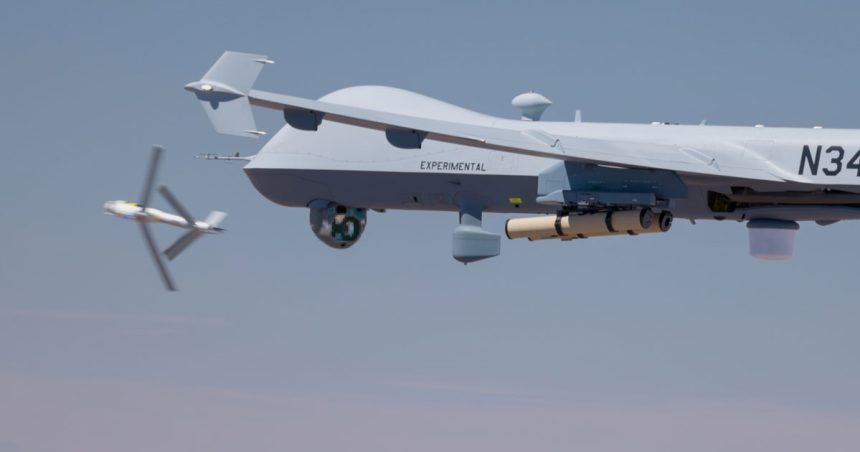GA-ASI and AeroVironment demonstrate first-ever air launch of Switchblade 600 from MQ-9A, advancing drone mothership concepts for smaller UAS.
General Atomics Aeronautical Systems, Inc. (GA-ASI) and AeroVironment have completed the first-ever air launch of a Switchblade 600 loitering munition from an MQ-9A Reaper, marking a significant milestone in unmanned systems integration and expanding the aircraft’s versatility in contested environments. The test took place between July 22 and 24, 2025, at the U.S. Army Yuma Proving Grounds, according to press releases from both GA-ASI and AeroVironment on Sep. 10.
During the test, an MQ-9A Block 5 carried and launched two Switchblade 600s, of which one was inert and one had a live high-explosive warhead. The control of the Switchblades was then successfully transferred from the Reaper’s ground control station to a separate operator on the ground closer to the target area.
“This cooperative effort showcased how combining different unmanned technologies could really provide value and effects to the warfighter,” GA-ASI President David R. Alexander said in the announcement. “By using MQ-9A to carry the Switchblade, the MQ-9A is able to stand off farther from enemy weapons systems and increase the range of the SB600, which will provide greater access and options in contested airspace.”
A New Role for the MQ-9A
Originally designed for Intelligence, Surveillance and Reconnaissance (ISR), the MQ-9A Reaper has steadily evolved to meet the requirements of the changing combat scenarios. The integration of the Switchblade 600 transforms the MQ-9 into a versatile mothership for smaller unmanned systems, extending its mission set by combining persistent surveillance with precision effects at extended ranges.

AeroVironment highlighted the broader operational relevance of the test, pointing to the system’s adaptability and use of satellite communications (SATCOM) for launch, control, and engagement. This enables beyond-line-of-sight operations and allows MQ-9s to provide long-range strike effects even when operating far from the battlefield.
“The ability to air launch and control Switchblade 600 from the MQ-9A UAS platform via SATCOM highlights the system’s adaptability and operational maturity,” said Wahid Nawabi, AeroVironment’s Chairman, President and CEO.
Switchblade 600 Capabilities
The Switchblade 600 is AeroVironment’s extended-range loitering munition, capable of more than 40 minutes of endurance and fitted with an anti-armor warhead to engage hardened targets. Its Electro-Optical/InfraRed (EO/IR) sensors provide real-time surveillance, target acquisition, and precision strike capabilities.
Operators can abort an attack mid-flight using its patented “wave-off and recommit” function, then re-engage the same or different targets. This is an important feature in today’s scenario, when the situation is constantly evolving and split-second decisions need to be made even when weapons are already on the way towards the target.

When air-launched from altitude, the Switchblade 600’s reach is significantly extended. AeroVironment noted that, when launched from an altitude of 30,000 feet, the munition can cover distances greater than 175 km using forward pass communication protocols. This allows Reaper crews to deliver effects well beyond the reach of conventional direct-attack weapons.
Building on the “Air-Launched Effects” Trend
The MQ-9/Switchblade test is part of a wider push by GA-ASI to transform its platforms into launch-and-control nodes for smaller unmanned systems, also known as Air-Launched Effects (ALE). In recent years, GA-ASI has already demonstrated several ALE projects:
- A2LE (Advanced Air-Launched Effects): Released from the MQ-20 Avenger in 2023, this additively manufactured small UAS was designed for rapid, low-cost production;
- Eaglet: A larger ALE first flown in 2022 from a U.S. Army MQ-1C Gray Eagle, designed for survivability and multi-domain sensing;
- Aerial Recovery System: Demonstrated in 2023 with the Avenger, showing how small UAS and ALE could be recovered mid-air using a towline and hoist system.
Together, these efforts illustrate GA-ASI’s vision of large unmanned aircraft serving as motherships for networks of expendable or recoverable drones, providing distributed sensing, strike, and electronic warfare in high-threat environments.

Operational Implications
Integrating the Switchblade 600 onto MQ-9As expands both reach and flexibility. In fact, instead of risking the Reaper itself near air defenses in today’s increasingly contested battlespaces, crews can launch loitering munitions from standoff distances, increasing survivability while maintaining precision effects. The ability to hand off control to forward operators ensures localized situational awareness and responsiveness.
The July test also demonstrates interoperability between major U.S. unmanned systems manufacturers, GA-ASI and AeroVironment, whose platforms are already widely fielded across the U.S. military and allied forces. Switchblade munitions are operational in multiple theaters, while the MQ-9 remains the backbone of U.S. and partner ISR and strike operations.
As conflicts increasingly emphasize dispersed, networked operations, the combination of long-endurance UAS and loitering munitions offers a scalable approach to striking time-sensitive targets, suppressing air defenses, or supporting ground maneuver. Similar concept are also envisioned by the U.S. Army, which is focusing on the introduction of ALEs as part of the Future Vertical Lift (FVL) program, the upgraded Black Hawk helicopter and also the Gray Eagle 25M. The Air Force similarly tested the deployment of Altius 600 sUAS from the Reaper as part of the Air Force Special Operations Command’s Adaptive Airborne Enterprise (A2E).
Looking Ahead
The successful air launch of the Switchblade 600 is likely to fuel further experimentation and integration across U.S. unmanned portfolios. Both GA-ASI and AeroVironment stressed that the achievement reflects not only technical progress but also the operational maturity of loitering munitions as standard tools in multi-domain warfare.

“This successful integration is more than a technical achievement—it’s a clear demonstration of what’s possible when proven systems are combined to create new operational advantages,” said Jimmy Jenkins, AeroVironment’s Executive Vice President for Precision Strike & Defense Systems.
While no operational deployment timeline has been announced, the demonstration validates concepts that could see MQ-9s, and potentially other Group 5 UAS, operate as central nodes in distributed kill webs. This would extend their role well beyond surveillance and direct attack into command-and-control for a new generation of unmanned systems.
The ability to recover the ALE/UAS in flight and even launching them again would open new possibilities, fully exploiting the long endurance of unmanned aircraft such as the MQ-9, which can stay in flight over 27 hours, according to GA-ASI.









